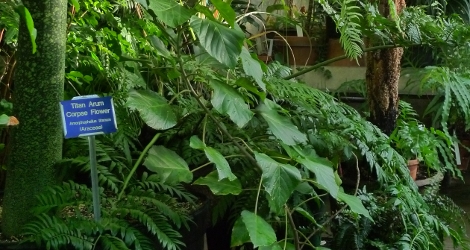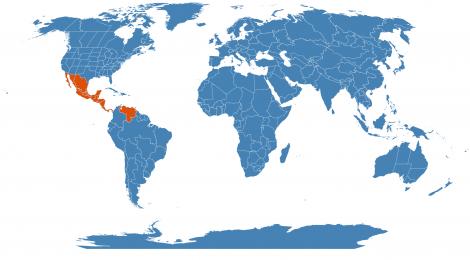Accession Data:
Plumeria rubra L.
- Common Name: Frangipani
- Family: Apocynaceae Juss.
- Description: Tree, to 25 feet; leaves broadly elliptic to ovate), and broadly tapering to each end; wider than oblanceolate.">obovate or oblong-lanceolate, to 20 inches long, obtuse to acuminate, with prominent marginal connecting vein, glabrous to densely pubescent beneath, petioles to 4.5 inches long; inflorescence rather open; corolla salverform, to 4.5 inches across, white with yellow center to various shades of rose and yellow, tube to 1 inch olng; follicles to 1 foot long.
Extrafloral nectaries in base of petiole, flower bud.
In mature trees, the large apex and leaves typical of the seedlings get smaller with each branching of the axis, a phenomenon called apoxogenesis.
Native from Mexico to Panama but widely cultivated in warm areas and in greenhouses.
- Uses: Traditional Medicine: All parts of this plant are used in traditional medicine to treat a wide range of maladies including: Decoction of bark is used as laxative in effect">purgative, emmenagogue, and febrifuge. Latex is similarly employed. Preventive for heat stroke: the material may be taken as a cooling tea. Root-bark taken internally as a strong purgative. Root-bark used as abortifacient. Root bark used as remedy for gonorrhea and venereal sores. Bark decoction used as antiherpetic. In India, bark used as purgative. Bark also used as application for abscesses. In Java and Madera, bark decoction used for gonorrhea, dropsy, and dysuria due to venereal disease. In Yucatan, latex is used for toothache. In Persia, bark is employed against blenorrhagia. For dysentery, diarrhea during summer season: use 12 to 24 gms of dried material in decoction. To treat arthritis, rheumatism, pruritic skin lesions mix the latex (sap) with coconut oil, warm, and apply to affected area. A decoction of the bark is used as a counterirritant on the gums for toothache. The latex mixed with coconut oil is used for itching. The juice is rubefacient in rheumatic pains, and with camphor, is also used for itching. A poultice of heated leaves is beneficial for swellings. Decoction of leaves for cracks and eruptions of the soles of the feet. Infusion or extract from leaves is used for asthma. Leaves also used as cigarettes to inhale in asthma. In Puerto Rico, in emulsion, the milk produces abundant, bilious, watery stools. In Mexico,a decoction of flowers used in diabetes.
Scientific studies have verified the following activity: • Cytotoxic, Antitumor, Antibacterial, Molluscicidal, Essential Oils, Pytochemical, Antimicrobial, Antioxidant, Hypolipidemic, Anti-Inflammatory, Free Radical Scavenging Activity, Antimutagenic.
Info from Philippine Alternative Medicine; http://www.stuartxchange.org/Kalachuchi.html
- IMPORTANT NOTE: Plant Uses are for informational purposes only. EEB Greenhouses assume no responsibility for adverse effects from the use of any plants referred to on this site. Always seek advice from a professional before using any plant medicinally.
- USDA Zone: 9b-11
Accession Data:
- Accession # 198500454
- Source: Unknown
- Accession Date: 12-31-1985
- Bench: 1215 - AUS:West Bench SS
- Currently: active - healthy
- Qty: 1 confirmed on 07-01-2025
- Restrictions:
- Poisonous Plant Parts - Not for Human Consumption
- Poisonous Plant Parts - Not for Human Consumption
Classification:
- Division: Magnoliophyta
- Class: Magnoliopsida
- SubClass: euasterid I
- Order: Gentianales
- SubOrder:
- Family: Apocynaceae
- SubFamily: Rauvolfioideae
- Tribe: Plumerieae
- SubTribe:
Flowering Data:
This accession has been observed in bloom on:| Year | Jan | Feb | Mar | Apr | May | Jun | Jul | Aug | Sep | Oct | Nov | Dec | ||||||||||||||||||||||||||||||||||||||||
|---|---|---|---|---|---|---|---|---|---|---|---|---|---|---|---|---|---|---|---|---|---|---|---|---|---|---|---|---|---|---|---|---|---|---|---|---|---|---|---|---|---|---|---|---|---|---|---|---|---|---|---|---|
| 2025 | ||||||||||||||||||||||||||||||||||||||||||||||||||||
| 2024 | ||||||||||||||||||||||||||||||||||||||||||||||||||||
| 2023 | ||||||||||||||||||||||||||||||||||||||||||||||||||||
| 2022 | ||||||||||||||||||||||||||||||||||||||||||||||||||||
| 2021 | ||||||||||||||||||||||||||||||||||||||||||||||||||||
| 2020 | ||||||||||||||||||||||||||||||||||||||||||||||||||||
| 2019 | ||||||||||||||||||||||||||||||||||||||||||||||||||||
| 2018 | ||||||||||||||||||||||||||||||||||||||||||||||||||||
| 2017 | ||||||||||||||||||||||||||||||||||||||||||||||||||||
| 2016 | ||||||||||||||||||||||||||||||||||||||||||||||||||||
| 2015 | ||||||||||||||||||||||||||||||||||||||||||||||||||||
| 2014 | ||||||||||||||||||||||||||||||||||||||||||||||||||||
| 2013 | ||||||||||||||||||||||||||||||||||||||||||||||||||||
| 2012 | ||||||||||||||||||||||||||||||||||||||||||||||||||||
| 2011 | ||||||||||||||||||||||||||||||||||||||||||||||||||||
| 2010 | ||||||||||||||||||||||||||||||||||||||||||||||||||||
References (internal):
- Medicinal Plants
- Moth pollination (phalaenophily)
- Plants with Extrafloral Nectaries
- EEB 3271 - Systematic Botany
- EEB 3203 - Developmental Plant Morphology
- Medicinal Plants - Traditional African Medicine
- EEB Greenhouse Holdings native to: Mexico Central / Mexico Northeast / Mexico Gulf / Mexico Northwest / Mexico Southwest / Mexico Southeast / Belize / Costa Rica / El Salvador / Guatemala / Honduras / Nicaragua / Panama / Venezuela /
References (external):
- The Plant List (2013). Version 1.1. Last accessed on Thursday, August 31, 2017.
- WCSP (2016). World Checklist of Selected Plant Families. Facilitated by the Royal Botanic Gardens, Kew. Last accessed on Thursday, August 31, 2017.
- Hortus Third, LH Bailey Hortorium, 1976
- The Plant Book, DJ Mabberly, 1987
data regenerated on Tue, 01 Jul 2025 11:21:08 -0400 [bcm v4.0]
Images:

Additional images for this accession:
Click on thumbnails to enlargeCurrent Accessions in the Apocynaceae
Subfamily Apocynoideae
Tribe Apocyneae
Subfamily Apocynoideae
Tribe Malouetieae
Subfamily Apocynoideae
Tribe Mesechiteae
Subfamily Apocynoideae
Tribe Nerieae
Subfamily Apocynoideae
Tribe Wrightieae
Subfamily Asclepiadoideae
Tribe Asclepiadeae
- Asclepiadinae: Asclepias curassavica


- Asclepiadinae: Asclepias tuberosa


- Asclepiadinae: Gomphocarpus fruticosus


- Cynanchinae: Cynanchum grandidieri W/C


- Cynanchinae: Cynanchum marnierianum


- Cynanchinae: Cynanchum pachycladon

- Cynanchinae: Cynanchum sp.
- Cynanchinae: Cynanchum verrucosum

Subfamily Asclepiadoideae
Tribe Ceropegieae
- Stapelieae: Caralluma hesperidum

- Stapeliinae: Ceropegia albisepta W/C

- Stapeliinae: Ceropegia ampliata


- Stapeliinae: Ceropegia ampliata


- Stapeliinae: Ceropegia aristolochioides

- Stapeliinae: Ceropegia cimiciodora
- Stapeliinae: Ceropegia fusca

- Stapeliinae: Ceropegia linearis subsp. woodii

- Stapeliinae: Ceropegia x rothii
- Stapeliinae: Ceropegia stapeliiformis


- Stapeliinae: Edithcolea grandis

- Stapeliinae: Hoodia gordonii

- Stapeliinae: Huernia piersii

- Stapeliinae: Huernia plowesii


- Stapeliinae: Huernia thureti var. thureti


- Stapeliinae: Huernia zebrina

- Stapeliinae: Larryleachia cactiformis

- Stapeliinae: Stapelia flavopurpurea


- Stapeliinae: Stapelia gigantea


- Stapeliinae: Stapelia grandiflora

- Stapeliinae: Stapelianthus madagascariensis


Subfamily Asclepiadoideae
Tribe Fockeeae
Subfamily Asclepiadoideae
Tribe Marsdenieae
- Dischidia albiflora


- Dischidia bengalensis

- Dischidia litoralis

- Dischidia major


- Dischidia ovata
- Dischidia ruscifolia

- Hoya australis ssp. australis
- Hoya carnosa


- Hoya carnosa x serpens

- Hoya curtisii
- Hoya imbricata

- Hoya imbricata

- Hoya macgillivrayi


- Hoya macrophylla

- Hoya obovata


- Hoya pubicalyx

- Hoya retusa
- Marsdenia floribunda


Subfamily Periplocoideae
Tribe Cryptolepideae
Subfamily Periplocoideae
Tribe Periploceae
Subfamily Rauvolfioideae
Tribe Alyxieae
Subfamily Rauvolfioideae
Tribe Carisseae
Subfamily Rauvolfioideae
Tribe Plumerieae
Subfamily Rauvolfioideae
Tribe Tabernaemontaneae
- Tabernaemontaninae: Tabernaemontana divaricata


- Tabernaemontaninae: Tabernaemontana elegans


Subfamily Rauvolfioideae
Tribe Vinceae
- Catharanthus roseus



- Rauvolfia serpentina


- Ochrosiinae: Ochrosia elliptica


 = indicates flowering in past 14 days
= indicates flowering in past 14 days
 = images available for this accession
= images available for this accession
 = map available for this accession
= map available for this accession
 = accession added within past 90 days
= accession added within past 90 days

